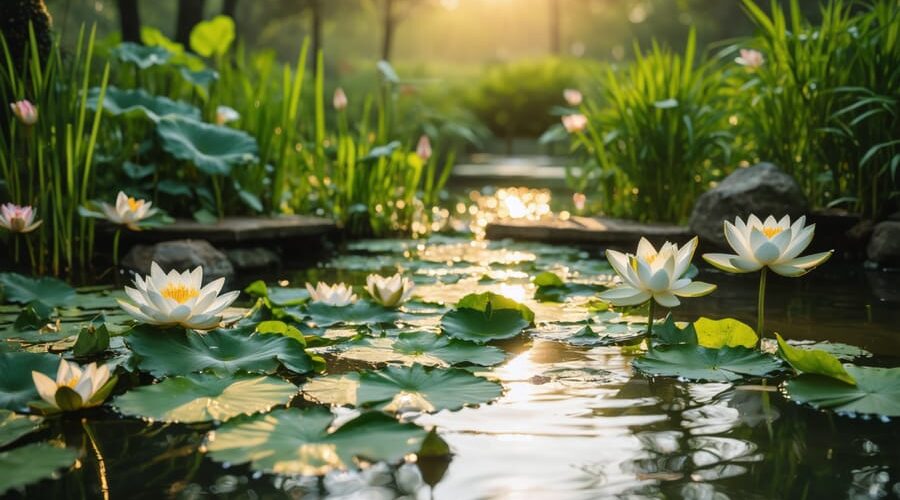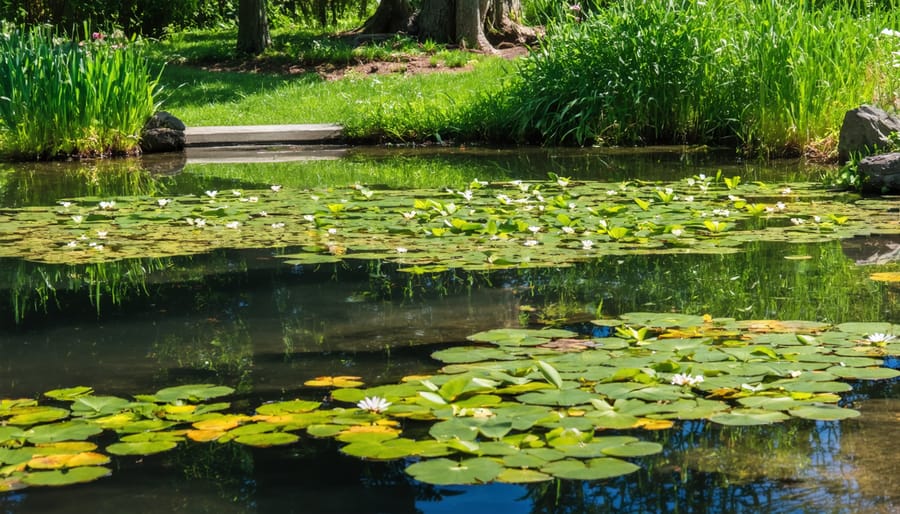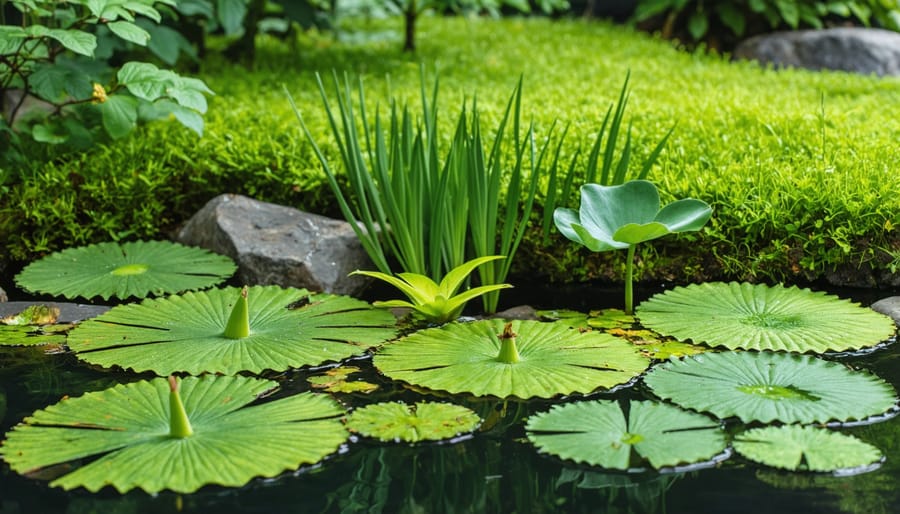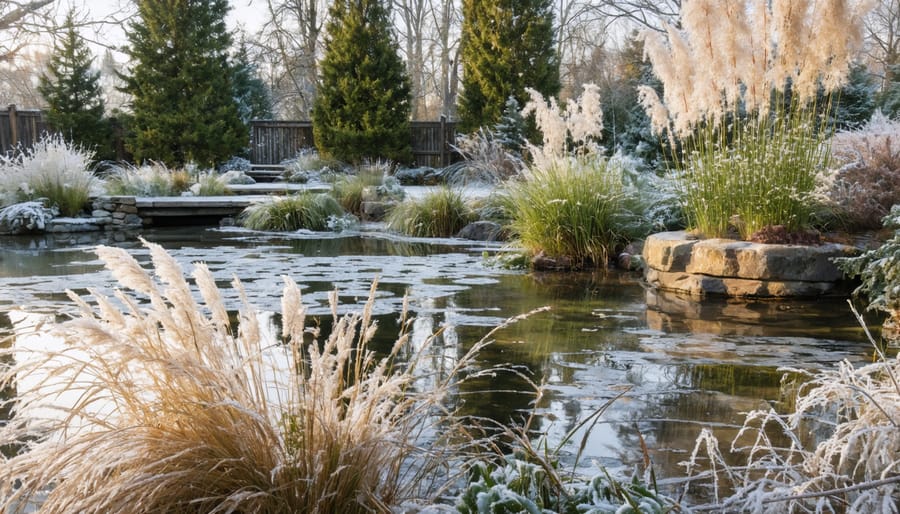
Transform Your Pond into a Living Canvas Through the Seasons
Transform your pond into a living canvas that evolves with each passing season, creating an ever-changing masterpiece of color, texture, and movement. Seasonal aesthetics in water garden design isn’t just about maintaining visual interest—it’s about orchestrating nature’s rhythm to tell a compelling story throughout the year.
From the delicate emergence of spring water lilies to the bold architectural statements of winter’s frozen formations, thoughtful pond design celebrates the distinct character of each season. Strategic placement of deciduous and evergreen plants, carefully selected hardscape elements, and the deliberate manipulation of water features work together to ensure your water garden remains a focal point regardless of the calendar.
What sets exceptional pond designs apart is their ability to anticipate and embrace seasonal transitions. Rather than fighting against nature’s cycles, successful water gardens incorporate plants and elements that shine in their designated season while gracefully receding to make way for the next act in this year-round performance. This approach creates a dynamic landscape that rewards visitors with fresh discoveries and renewed appreciation throughout the changing seasons.
Whether you’re planning a new installation or enhancing an existing water feature, understanding the principles of seasonal aesthetics will elevate your pond from a simple water feature to a sophisticated living artwork that captivates in every season.
Spring: Awakening Your Water Garden
Early Spring Bloomers
As winter fades, early spring bloomers bring the first splashes of color to your pond landscape. These aquatic pioneers are essential for creating that magical transition from dormancy to vibrant life. By incorporating these smart planting secrets, you can ensure your pond awakens with stunning visual impact.
Marsh marigolds are often the first to emerge, dotting the pond edges with cheerful yellow blooms as early as March. Place these hardy perennials near the water’s edge where they can dip their toes in the shallows. They’re perfect companions for early-blooming iris varieties, which add vertical interest with their sword-like foliage and delicate flowers.
Don’t overlook the charm of water forget-me-nots, which create carpets of tiny blue flowers just inches above the water. These low-growing beauties work wonderfully in the foreground of your pond, especially when paired with taller marginal plants.
For maximum impact, cluster your early bloomers in groups of three or five, focusing on areas visible from your favorite viewing spots. Consider placing some near walkways or seating areas where you can enjoy their earliest appearances. Remember to include some evergreen marginals like sweet flag or rushes to provide structure while waiting for these spring stars to emerge.

Spring Color Transitions
Spring brings an ever-changing palette to your pond landscape, and planning for these color transitions can create a stunning visual journey throughout the season. Start with early bloomers like snowdrops and winter aconite in late winter, which provide those first pops of white and yellow as winter recedes.
As temperatures warm, incorporate different varieties of daffodils that bloom in succession. Early varieties burst forth in March, followed by mid-season and late bloomers extending into April. Plant them in clusters around your pond’s edge for maximum impact.
Layer your color progression with spring bulbs at varying heights. Low-growing muscari (grape hyacinths) create carpets of blue, while tall tulips can provide bold strokes of color above. Choose tulip varieties in complementary colors that bloom at different times to maintain continuous interest.
Don’t forget about foliage colors! Early spring perennials like heuchera and Japanese painted ferns offer beautiful leaf textures and hues that complement your blooming plants. As spring progresses, emerging water lily pads add fresh green touches to your pond’s surface.
Consider incorporating flowering trees and shrubs near your pond for vertical interest. Dogwoods, redbuds, and flowering cherries create beautiful reflections in the water while contributing to your spring color story. Plan your combinations so that as one plant’s blooms fade, another takes center stage, ensuring your pond area remains vibrant throughout the entire season.
Summer: Peak Season Drama

Layering Water Plants
Creating depth in your water garden is like painting a living canvas, where each layer adds new dimension and visual interest. By thoughtfully arranging plants of different heights, you can achieve stunning natural textures and layers that draw the eye through your aquatic landscape.
Start with low-growing carpet plants like water lilies that float gracefully on the surface. These create your foundation layer and provide essential coverage for fish while adding splashes of color. Just behind these, position mid-height plants like marsh marigolds or iris, which stand proudly above the water’s surface and create a gentle transition to taller specimens.
Your background layer should feature dramatic vertical elements like cattails, rushes, or umbrella plants. These towering beauties not only provide a stunning backdrop but also offer natural screening and wildlife habitat. Don’t forget to include some marginal plants along the edges, which soften the transition between water and land.
For the most dynamic effect, group plants in odd numbers and vary their spacing. Create small islands of vegetation rather than forming rigid lines. This natural-looking arrangement mimics what you’d find in nature and provides year-round interest as different plants take turns showing off their best features through the seasons.
Remember to consider each plant’s mature size when planning your layout, leaving enough space for growth while maintaining the desired layered effect. This thoughtful arrangement will reward you with a pond that looks professionally designed and naturally beautiful.
Summer Light and Shadow Play
Summer presents a unique opportunity to create stunning visual displays using nature’s most dramatic lighting source – the sun. By strategically placing plants and decorative elements, you can harness sunlight to create captivating shadow patterns throughout your pond area. These natural dynamic lighting effects change throughout the day, bringing your water garden to life in different ways.
Tall ornamental grasses are perfect for creating graceful, dancing shadows across your water’s surface. Position them along the western edge of your pond to cast dramatic afternoon silhouettes. Japanese maples, with their delicate leaf patterns, can create intricate shadow plays when planted where the morning sun can shine through their canopy.
Consider adding architectural elements like bamboo screens or decorative panels at strategic points. These will create interesting patterns that shift with the sun’s movement, adding depth and visual interest to your pond design. Even simple features like carefully placed rocks can cast compelling shadows that transform your pond’s appearance throughout the day.
Remember to observe your pond at different times to understand how sunlight interacts with your space. Early morning and late afternoon typically offer the most dramatic lighting effects, as the low-angle sunlight creates longer, more pronounced shadows. This natural light show adds an ever-changing dimension to your pond’s aesthetic appeal without any additional energy costs.
Autumn: Embracing the Change
Fall Foliage Features
When autumn arrives, your pond landscape can burst into a spectacular display of warm colors that perfectly complement the reflective water surface. Japanese maples are exceptional choices for fall color, with varieties like ‘Bloodgood’ and ‘Osakazuki’ offering brilliant scarlet displays. Position these stunning trees where their colors will mirror in your pond’s surface, creating a double impact of autumn beauty.
Consider incorporating deciduous shrubs like burning bush and oakleaf hydrangea along your pond’s edges. These plants not only provide rich burgundy and purple fall colors but also create interesting textures that persist into winter. Virginia sweetspire is another excellent choice, offering cascading branches that turn deep red and purple in autumn.
Don’t overlook the importance of perennials in your fall display. Ornamental grasses like maiden grass and switch grass turn golden in autumn and provide movement as they sway in fall breezes. Their plumes create striking reflections on still water surfaces. Plant these in groups of three or five for maximum impact.
For groundcover around your pond, consider creeping wintergreen or wild ginger, which maintain interest through fall while transitioning to deeper hues. These low-growing plants help prevent soil erosion around your pond edges while contributing to the seasonal color palette.
Remember to position your fall-interest plants where falling leaves won’t overwhelm your pond, making maintenance easier while still allowing you to enjoy the full spectacle of autumn colors.
Seasonal Transitions
As summer’s vibrant blooms begin to fade, transitioning your pond’s aesthetic to fall doesn’t have to feel jarring. Start by gradually introducing autumn elements while summer plants are still thriving. Add ornamental grasses that will develop beautiful golden hues, and consider incorporating hardy chrysanthemums near the pond’s edge for pops of seasonal color.
Remove spent summer blooms and yellowing foliage promptly to maintain a tidy appearance during the transition. This is also the perfect time to add fall-blooming water plants like marsh marigolds or Japanese anemones, which bridge the seasonal gap beautifully. Consider incorporating elements that will provide structure throughout the changing seasons, such as decorative rocks or artistic driftwood pieces.
Pay attention to your pond’s surroundings too. Plant fall-blooming perennials like sedum and asters near the water’s edge to maintain visual interest. As temperatures cool, floating leaves from nearby trees can actually add to your pond’s autumn charm – just be sure to remove excess debris to maintain water quality.
Don’t forget about lighting! As days grow shorter, strategically placed underwater lights can highlight architectural elements and create magical reflections on autumn evenings. Adding copper or bronze garden accessories can complement fall’s warm color palette while providing year-round interest.
Remember, the key to a successful seasonal transition is planning ahead and working with nature’s rhythm rather than against it.
Winter: Finding Beauty in Simplicity
Structure and Form
The backbone of year-round pond aesthetics lies in creating a strong structural foundation. By incorporating permanent sculptural elements and evergreen plants, you’ll maintain visual interest even during dormant seasons.
Start with larger architectural features like decorative rocks, boulders, or weather-resistant garden art. Position these elements strategically around your pond to create focal points that draw the eye year-round. Consider adding a stone pathway or decorative bridge that not only serves a practical purpose but also adds character to your water garden.
Evergreen plants are your best friends for maintaining structure throughout the seasons. Japanese Holly, Boxwood, and dwarf conifers provide reliable greenery and can be shaped to complement your pond’s design. Plant them at varying heights to create depth and dimension. Place taller varieties at the back of your pond and shorter ones in the foreground to frame the water feature naturally.
Don’t forget about vertical elements – bamboo screens, trellises, or pergolas can add height and create interesting shadows on the water’s surface. These structures also provide support for climbing plants, adding another layer of visual interest as seasons change.
Remember to leave enough open space between structural elements to accommodate seasonal plants, ensuring your pond design can evolve throughout the year while maintaining its core aesthetic appeal.

Winter Water Features
Winter transforms water features into magical focal points when managed correctly. Even in freezing temperatures, your pond can become a stunning ice sculpture that captures the essence of the season. To maintain both beauty and functionality, start by installing a floating de-icer to keep a small area free from ice, ensuring proper gas exchange for any overwintering fish.
Consider adding lighting elements that reflect off ice and snow, creating dramatic shadows and sparkles during the shorter days. Underwater lights are particularly effective, as they illuminate ice formations from below, creating ethereal effects after dark. Hardy ornamental grasses left uncut around the pond’s edge catch frost and snow, adding natural winter interest.
For moving water features like fountains and waterfalls, you have two options. Either winterize them completely by draining and covering, or keep them running at a reduced flow rate to create fascinating ice sculptures. If you choose to keep them running, monitor ice buildup regularly to prevent damage to pumps and plumbing.
Don’t forget about winter wildlife – your pond can become a vital water source for birds when other water sources freeze. Installing a heated bird bath nearby adds both functionality and visual interest. Place decorative elements like colorful winter berries or evergreen branches strategically around the water feature to enhance its winter appeal while providing natural shelter for visiting wildlife.
Creating a pond that captivates throughout the year isn’t just about seasonal planning – it’s about crafting a living masterpiece that evolves and surprises with each passing month. As we’ve explored, every season brings its own unique opportunities to showcase nature’s beauty in your water garden.
Remember that successful seasonal design starts with a strong foundation. By incorporating both permanent features and changing elements, you can ensure your pond remains visually interesting even during quieter periods. The key is to think ahead and plan for transitions, allowing one season’s beauty to seamlessly flow into the next.
Don’t be afraid to experiment with different combinations of plants, rocks, and decorative elements. Your pond is a personal expression of your creativity, and there’s no single “right way” to design it. Take notes throughout the year about what works well and what could be improved, and use these observations to refine your approach.
Consider starting small with seasonal additions and gradually expanding your collection as you gain confidence. Even simple changes, like adding colorful plants or updating lighting arrangements, can dramatically impact your pond’s appearance. The joy of seasonal pond design lies in the journey – watching your vision come to life and evolve throughout the year.
Most importantly, remember that your pond is a living ecosystem that deserves care and attention in every season. By embracing each season’s unique characteristics, you’ll create a dynamic and engaging water feature that brings year-round joy to your outdoor space.
